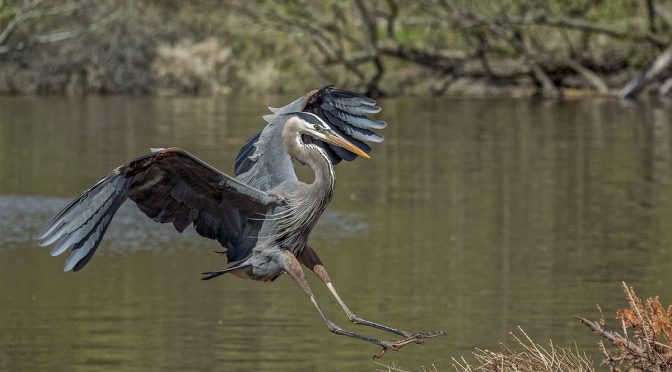Many of us who enjoy photographing birds in flight focus our efforts on specific bird behaviours including hunting/fishing, taking off, and landing. It is always a special moment when we can capture a subject bird doing something other than a typical fly-by. This article shares a selection of seven consecutive images and discusses landing postures that create anticipation in our bird photographs.
Our subject bird in this article is a Great Blue Heron. Let’s have a look at the first image in our series.

In this photograph we can see that our subject bird has dropped its legs into a downward position. This is a clear signal that it intends to land. This leg position creates a relatively small amount of anticipation in the image.

Our second image shows landing postures that communicate a bit stronger feeling of anticipation. The heron’s legs are just beginning to be drawn up in preparation for landing. We can see its body is a bit more hunched over and a fuller spread of wing feathers are visible.

In the frame above, landing postures have increased further. The heron’s legs are up a bit closer to its body and its head is slightly thrust forward. We can also see that its body is rotating slightly… towards a 90-degree upright position. All of these small changes in landing posture help to create more anticipation in the photograph.

The fourth frame in our series illustrates a couple of additional, subtle differences in landing posture. The heron’s head is now tilted down slightly as it locks its gaze in on its landing spot. We can also see the toes on its feet are being stretched open. If you compare the neck and head angle in frame four versus frame one, you’ll see that the heron looks much more intense in frame four. These landing posture differences create more anticipation in the photograph.

In frame five we see the heron’s toes are well spread, and the bottom portions of its legs are now parallel to the surface of the water. Its head is tilted slightly more towards the ground. All of these landing postures build anticipation.

The image above is now communicating a high degree of anticipation. The heron’s legs are thrust forward in preparation for landing. Its toes are well spread and the main flight feathers on its wings are also in a spread position.

Our final photograph has the highest feeling of anticipation. The heron’s body is now tilted slightly backwards. Its head and neck are pulled back in to help absorb the shock of landing. Legs are thrust well forward and toes fully extended. The proximity of the heron’s toes to the landing surface also helps to create a feeling of anticipation.
Waiting for landing postures that create anticipation will help make your bird images more interesting and unique.
Often when photographing birds coming in to land we fire off our AF-C (continuous auto-focus) run a bit too early. As a result we miss the drama and anticipation that occurs just before it touches down.
To capture a stronger feeling of anticipation in your images, be patient with your shutter finger. Wait for the bird’s legs to drop down and its body to begin to pivot forward. If you fire your AF-C run at this point, you’ll have a much better chance of getting an image that captures a stronger feeling of anticipation.
Technical Note:
All photographs were captured hand-held using camera gear as noted in the EXIF data. Camera was set to manual mode, with Auto ISO 160-3200. Continuous auto-focus with subject tracking was used with a frame rate of 20 frames per second. All images are displayed as 100% captures without any cropping done to them at all. All images in this article were produced from RAW files.
Word of mouth is the best form of advertising. If you like our website please let your friends and associates know about our work. Linking to this site or to specific articles is allowed with proper acknowledgement. Reproducing articles, or any of the images contained in them, on another website or in any social media posting is a Copyright infringement.
My intent is to keep this photography blog advertising free. If you enjoyed this article and/or my website and would like to support my work, you can purchase an eBook, or make a modest $10 donation through PayPal. Both are most appreciated. You can use the Donate button below. Larger donations can be made to tom@tomstirr.com through PayPal.
Article and all images are Copyright 2019 Thomas Stirr. All rights reserved. No use, duplication or adaptation of any kind is allowed without written consent. If you see this article reproduced anywhere else it is an unauthorized and illegal use. Posting comments on offending websites and calling out individuals who steal intellectual property is always appreciated!


Just wanted to comment that this article is still useful in 2025. I’m a digital artist and specifically wanted the landing posture of winged creatures. This touched EXACTLY what i wanted to capture, so thanks!
Great article. I enjoyed it!
Thanks Vern!
Tom